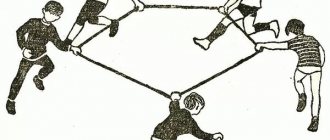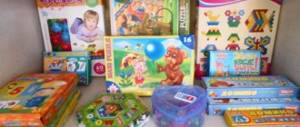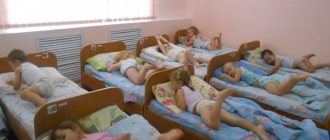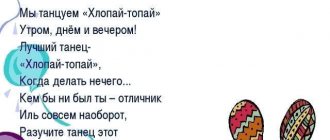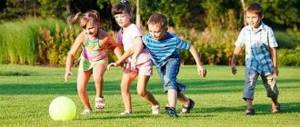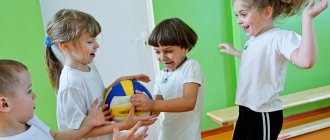Outdoor game "Silence".
Goal: to train children to walk in a column one at a time.
Progress of the game: Walk in a column, one at a time, around the site behind the teacher and recite the lines of the poem together:
Silence by the pond, the grass does not sway.
Don't make noise, reeds, go to sleep, kids.
At the end of the poem, the children stop, squat, bow their heads and close their eyes. After a few seconds, the teacher says loudly: “Kva-kva-kva!” - and explains that the frogs woke up the guys, and they woke up, got up and stretched.
L.I.Penzulaeva “Physical training in kindergarten” (second junior group), M., 2009
Outdoor game “We stomp our feet.”
Goal: to train children to act in accordance with the text of the poem, to run in a circle.
Progress of the game: The teacher and the children stand in a circle at a distance of arms straightened to the side. In accordance with the spoken text, children perform exercises:
We stomp our feet, we clap our hands, we nod our heads.
We raise our hands, we lower our hands, we give our hands.
With these words, the children give each other hands and continue:
And we run around and around and around.
After a while, the teacher says: “Stop!” Children slow down and stop. When running, you can invite children to lower their hands.
L.I.Penzulaeva “Physical training in kindergarten” (second junior group), M., 2009
Outdoor game “Cucumber, cucumber.”
Purpose: to train children to run in all directions, jump on two legs and move forward, to use the entire space of the hall.
Progress of the game: On one side of the hall there is a “mouse” teacher, on the other side there are children. They approach the “mouse” by jumping on two legs. The teacher says:
Cucumber, cucumber, don’t go to that end,
A mouse lives there and will bite your tail off.
Children run beyond the conventional line to their “house”, and the teacher catches up with them.
L.I.Penzulaeva “Physical training in kindergarten” (second junior group), M., 2009
Outdoor game "Hen and Chicks".
Target:
train children to act on a signal from the teacher, walk, run in all directions, crawl under an obstacle without touching the floor with their hands, use the entire area of the hall
Progress of the game: Children playing pretend to be chickens, the teacher is a hen. The chickens and the hen are kept in the house (a place fenced off with a rope stretched between posts or chairs at a height of 35-40 cm).
An imaginary big bird lives off to the side. The hen crawls under the rope and goes in search of food. She calls the chickens: “Ko-ko-ko-ko.” At her call, the chickens crawl under the rope, run to the hen and walk with her, bend over, squat, and look for food. According to the teacher, “The big bird is flying!” all the chickens quickly run away and hide in the house... When the chickens return home, running away from the big bird, the teacher can raise the rope higher so that the children do not touch it.
T.I.Osokina “Physical education in kindergarten” (second junior group)
Outdoor games for preschoolers
"Who came first?"
Let's sit in a circle facing the middle on small chairs placed one step apart from each other. The presenter calls the names of two children sitting next to each other. Those named stand up, go beyond the line of chairs and stand with their backs to each other. The rest of the players, together with the adult, clapping their hands, counted: “One, two, three, run!” - and the couple runs - one in one direction, the other in the other. The one who reaches his place first wins. The couple can only run using the word “run”. Complication: you can do without chairs and just stand in a circle.
"Mice".
On one side of the room or area there are mouse holes; Opposite is a storage room. Objects (cubes, cones, spools, etc.) representing products - cheese, butter, flour, cereal, etc. are placed in the pantry. At a signal from an adult, mice run out of their holes, go to the pantry and “eat” there. At the signal “cat,” the mice run into their holes, and the cat tries to catch them. You can run out of holes and run into holes only when given a signal. Caught mice sit aside. The game action ends when all the mice are caught.
"Cat and kittens."
Each cat has several kittens. You can take hoops or draw circles - each cat and kittens have their own home. When mothers fall asleep, sitting on chairs or sitting cross-legged on the floor, the kittens run away from them and begin to run around the room. At the signal “meow,” the kittens run to their mothers’ houses. Kittens may scatter around the room when mother cats fall asleep. The “meow” signal is given first by the leader, then by the cats in turn.
"Train".
The players stand in single file, at the back of the head. Each of them depicts a carriage; there is a steam locomotive in front. The adult blows the whistle, the locomotive whistles, and the whole train begins to move - slowly at first, then the pace becomes faster and faster. Despite the simplicity of the game's actions, it can be difficult for players to keep up with the same pace. When the train approaches a station (pre-marked location), it slows down and stops. At a signal from an adult, the horn is sounded and movement resumes. The train can only move after the whistle blows. All players can buzz.
"Sparrows and the cat."
The kids stand on some small elevation (bench) - these are sparrows on the roof. A sleeping cat (one of the players) is sitting to the side. At the signal: “Sparrows, fly” - the sparrows fly off the roof, spread their wings (raising their arms to the sides), and “fly” everywhere. The cat wakes up, says “meow” loudly and catches the sparrows who are trying to hide on the roof. The birds that the cat managed to catch, he leads to his house.
“Catch it, throw it, don’t let it fall.”
The kids stand in a circle, one of them has a ball in his hands. The player with the ball says: “Catch it, throw it, don’t let it fall,” and throws the ball to the person standing next to him in a circle. Whoever drops the ball is out.
"Catch a mosquito."
The players stand in a circle (arms length). The driver is in the center of the circle. He holds a rod (1 m long). A cord is attached to the end of the rod, to which a mosquito (made of paper or cloth) is attached. The driver circles the mosquito a little higher than the children's heads. When a mosquito flies overhead, the players jump up and try to catch it with their hands. A child who catches a mosquito is given a clap as a reward.
"Geese."
This is an active game known to everyone since childhood. In one part of the room or area the geese's house is outlined, and in the other - a meadow. A shepherd (adult) with a twig in his hands takes the flock to the meadow and returns home. Meanwhile, the geese are grazing. After a certain time, the shepherd begins to call the poultry: “Geese, geese.” They answer: “Ha, ha, ha.” The shepherd can call the birds several times, but as soon as he says “Well, fly home!”, the geese, stretching out their arms to the sides and waving them, run across the field home. The best is considered to be the one who runs home first when called.
Complication: a new character appears - a wolf who catches geese flying home. The wolf takes the caught birds to his lair, from where the geese do not have the right to leave of their own free will, but only after the end of the game activities. Thanks to such complications, schoolchildren enjoy playing these simple outdoor games.
"What's Hidden"
The players sit down at the table. There are 3–5 different things on the table. The players look carefully at the things lying there and try to fill them. One child, at will or in turn, moves away from the table to the side, while some of the things are hidden. The driver, approaching the table, must guess what is hidden.
"Who is faster?"
The players walk around the room (area) in single file, while the leader is singing or to the drum, some of them are holding red flags in their hands, others are blue. At the signal “Stop!” the players stop. The presenter says: “One, two, three, everyone run here!” - raises a red flag, or a blue one, or both together, and the players must line up in single file against the flag of their own color. The one who runs to the flag the fastest wins. Instead of flags, you can use colored ribbons.
11. “Guess what’s in your hand.”
Players sitting at a table or standing in a circle with their hands behind their backs. An adult, going around the players, puts a small object in each person's hands, for example, a cube, a ball, a cone, etc. Having received the object, the child names it and then shows it. If a child names an object incorrectly, then all children, after the demonstration, pronounce the name of this object in unison. Children are given only familiar objects.
“Find it.”
Lay things out on the table and cover with a scarf. Children take turns coming to the table, putting their hand under the scarf and by touch finding an object named by one of the children. The kid who pulled out the named object correctly gets a clap. Option: sit in a circle. Things are in a bag. An adult approaches each person in turn and offers, without looking, to take the named item out of the bag.
Outdoor games develop children socially, emotionally, physically and mentally. And that's great! Have a fun holiday.
To be continued…
0
Modification of the outdoor game “Cat and Mice” card index on the topic
Municipal budgetary preschool educational institution – Child Development Center kindergarten No. 5 “Golden Key” of the Strezhevoy urban district
Modification of an outdoor game
"Russian folk outdoor game"
Stikhilyas Lyudmila Dmitrievna.
physical education instructor
1 section.
GAME “CAT AND MICE”
(Game of medium mobility, round dance, source - “Music and Movement”, collection of games - M., 1999))
Purpose of the game: development of dexterity, attention, sense of rhythm, verbal memory, collective interaction, desire for mutual assistance.
Equipment and game materials for the game: you can prepare elements of cat and mouse costumes (hats, tails)
Choosing a presenter and driver: it is more appropriate for a teacher to act as a presenter - he explains the rules and monitors the progress of the game. To choose a cat and a mouse, you can use a song-song, which is then spoken during the game: this will help children learn the text at the same time:
The mice dance in circles
The cat is dozing on the bed,
Hush, mice, don't make noise,
Don't wake up Vaska the cat:
How Vaska the cat wakes up,
It will break up the whole round dance!
Description of the course of the game: the players lead a round dance, in the center of which there is a mouse - this is its “house”, pronouncing or singing words. As soon as the song is over, the players understand their hands without opening them - “the doors open”, the mouse runs out and runs from the cat, who was waiting for her outside the round dance.
Rules and conditions of the game:
If the cat manages to catch the mouse, the game ends. You can make the cat a mouse or choose a new pair.
The cat has no right to run into the circle.
The mouse has no right to stay in the house for too long during the chase - only run in and immediately run out.
Players in a round dance must be attentive and careful - they must not suddenly lower their hands so as not to hit the leaders.
Possibility of complicating the game: you can choose two mice, two cats.
Section 2
GAME “CAT and MICE” (5-7 years old)
Purpose of the game: development of dexterity, intelligence, attention, the ability to coordinate movements with words. They practice running and dodging, catching and forming a circle.
Equipment and game materials for the game: you can prepare elements of cat and mouse costumes (hats, ribbons)
Number of participants: 25-30.
Choosing a presenter and driver: it is more appropriate for a teacher to act as a presenter - he explains the rules and monitors the progress of the game.
Description of the game: The mice stand in a circle. Everyone receives a strip of colored material or a ribbon, which he places in the back of his belt. A cat sleeps in the center of the circle. The mice dance in a circle, pronounce or sing words.
The mice dance in circles
The cat is dozing on the bed,
Hush, mice, don't make noise,
Don't wake up Vaska the cat:
How Vaska the cat wakes up,
It will break up the whole round dance!
As soon as the song ends, the mice scatter around the playground, the cat wakes up and runs after the mice, trying to pull a ribbon from one of them. The mouse that has lost its ribbon temporarily moves aside.
At the teacher’s signal, the children line up in a circle. The cat counts the number of ribbons taken and returns them to the mice.
Each time the game lasts no more than 1-2 minutes, the total duration of the game is 5-7 minutes.
Rules and conditions of the game:
1.You cannot hold the ribbon with your hands.
2. If the cat cannot pull out a single ribbon within 1-2 minutes, the teacher assigns another.
3. The ribbon should be placed behind the belt in such a way that its end hangs down and can be freely grabbed by hand.
4. Finishing the game, the teacher notes those cats that managed to draw the most ribbons, and those mice that never lost their ribbons.
5.If the area is large, then you need to mark its boundaries with flags or draw lines so that the mice, running away from the cat, do not run across the boundaries.
Possibilities for complicating the game:
1.You can choose two cats.
2.You can hang ribbons of two colors. One cat rips off one color of ribbon, another another.
GAME “CAT and MICE” (5-7 years old)
Purpose of the game: development of dexterity, jumping, attention, sense of rhythm, verbal memory.
Equipment and game materials for the game: you can prepare elements of cat and mouse costumes (hats, tails)
Number of participants: 25-30.
Choosing a presenter and driver: it is more appropriate for a teacher to act as a presenter - he explains the rules and monitors the progress of the game.
Description of the game: A circle is drawn on the ground. One of the players stands in the middle of the circle - he is a cat. And around the circle the mice dance in a circle.
The mice dance in circles
The cat is dozing on the bed,
Hush, mice, don't make noise,
Don't wake up Vaska the cat:
How Vaska the cat wakes up,
It will break up the whole round dance!
After the words, the mice jump over the line of the circle and, if there is no danger of being grabbed by the cat, they remain inside the circle for some time. Continue jumping on two legs in place, or move forward to the center of the circle. The mice try to dodge the cat and jump out of the circle in time. Whoever the cat grabs becomes a cat, and the cat becomes a mouse.
Each time the game lasts no more than 1-2 minutes, the total duration of the game is 5-7 minutes.
Rules and conditions of the game:
1. Players are only allowed to jump out of the circle. The one who runs out of the circle leaves the game.
2. The cat chases the mice, also jumping on two legs.
3. If the cat cannot catch a single mouse within 1-2 minutes, the teacher assigns another one.
4. Finishing the game, the teacher marks those cats that managed to catch the mouse, and those mice that never fell into the cat’s paws.
Possibilities for complicating the game:
1.You can choose two cats.
2.You can jump on one leg (right or left).
